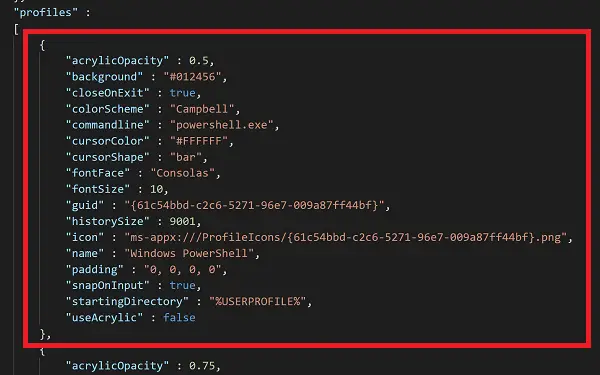With Windows Terminal, the company is trying to bring all the command-line based utilities under one UWP shell. Out of the box, it includes Windows PowerShell and Windows Command Prompt – but if someone wants, they can include another command-line tool too. This includes Git Bash, WSL command lines, Anaconda command line, and more.

Add Custom Command Line in Windows Terminal
To add custom command line in Windows Terminal, you will have to config the JSON file for Windows Terminal manually.
First of all, copy the block of code highlighted below:
{
"acrylicOpacity" : 0.5,
"background" : "#012456",
"closeOnExit" : true,
"colorScheme" : "Campbell",
"commandline" : "<PATH>",
"cursorColor" : "#FFFFFF",
"cursorShape" : "bar",
"fontFace" : "Consolas",
"fontSize" : 10,
"guid" : "{GUID IS HERE}",
"historySize" : 9001,
"icon" : "ms-appx:///ProfileIcons/{GUID IS HERE}.png",
"name" : "<NAME>",
"padding" : "0, 0, 0, 0",
"snapOnInput" : true,
"startingDirectory" : "%USERPROFILE%",
"useAcrylic" : false
},
Paste this code snippet in the “profiles’ block inside the JSON file mentioned above.
Now you need to create a custom GUID for your command line.
Generate a new GUID for your application here.
Copy that newly generated GUID in the code snippet given above.
Make subtle changes like app name and icon customization in the code snippet.
Enter the path for the new command line’s executable file in the “commandline” element of the code block we just copied in the given JSON file and save the file.
Relaunch the Windows Terminal to find the newly added command line ready to launch from the arrow key.
I hope you found this guide useful!
TIP: This post shows how to reset Windows Terminal settings to default.
Also read: Windows Terminal Tips and Tricks to make you work like a Pro.
Leave a Reply